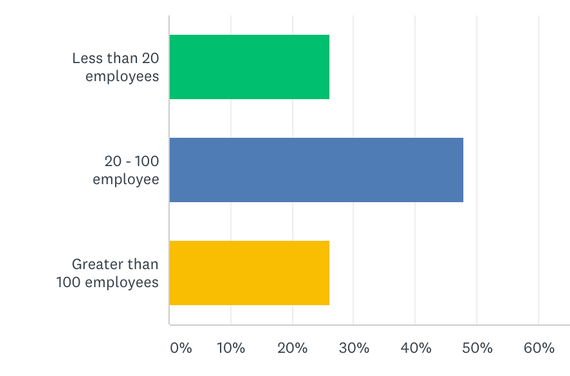Over the last two weeks, BSCs were polled to inquire about their turnover numbers and recruitment methods. The goal of this quick study was to understand how companies were recruiting, which methods were working best, and how those methods were affecting turnover. While the questions were few, the hope was to find if there was any correlation between lower turnover and certain types of recruitment methods. Additionally, I wanted to give BSCs a way to compare their own efforts and results to that of their peers. Here is a breakdown of the poll and its results.
The Size Factor
26% of all respondents had less than 20 employees, 26% of all respondents had greater than 100 employees, and the remaining 48% had between 20 and 100 employees. While this is not representative of the industry as a whole, it is a fair representation of the companies on my email list and participating in the Elite Mastermind Group. In some of the results below, I will discuss how the size of the company affected the results.
Employee Turnover
Surprisingly, the turnover numbers were much stronger than what you hear are industry averages. I’ve heard industry average employee turnover rates ranging from 150% to 200%. However, the survey results have over 60% of respondents reporting a turnover less than 70%, with over half of those being less than 40% annual turnover. 21% of respondents had turnover greater than 130% annually. I would guess that my numbers are slightly skewed (in favor of lower rates) for a variety of reasons. However, I think the numbers are instructive.

The key takeaway from the data was this: turnover was no respecter of company size. Put another way, each turnover range had an even distribution of large, medium, and small companies. Small companies had low and high turnover. Medium and large sized companies had low and high turnover. The turnover rates were not lopsided in any way. While many conclusions could be drawn from this small amount of data, one thing seems to be clear: turnover is no respecter of size. Therefore, no matter your company size, you likely can improve your turnover numbers through good hiring and retention practices.
**There are other factors that could affect the turnover numbers. Some of these are part time vs. full time jobs, location, job types, shifts, etc. A more in depth study would be able to draw out some potential correlations. However, our sample size and distribution were large enough and diverse enough to make me comfortable in assuming that turnover is not dictated by company size.
Recruitment Methods
The results of the recruiting portion of the survey were fairly predictable. Employee referrals were the highest rated, followed by Indeed, Other, and Facebook. Predictably, newspaper and radio ranked near the bottom. However, one low-ranking recruitment method that was surprising was Craigslist, coming in next to last. My guess is that Craigslist at one time had more recruiting power, but has since diminished due to some markets charging fees, others being inundated with ads, etc.

While turnover was not definitively associated with one recruitment method, there was one clear takeaway from the recruiting section: employee referrals are still the #1 source. They always have been and always will be number one. Knowing this, you must harness employee networks to expand your hiring pool. A-players attract other A-players and you should capitalize on this truth. How can you improve employee referrals?
- Referral bonus: The obvious answer is to offer referral bonuses when a current employee refers someone to the company and they stay for a certain amount of time.
- Be a great place to work: If you cultivate a great company culture, your people will want to tell others about it; hence, driving referrals. Want more referrals? Treat your people REALLY well.
- Communicate hiring needs: This is perhaps something we often overlook. We don’t tell the people working for us what hiring needs we have. We pay to publish our ads, but won’t freely tell our own workforce? If you have 50 employees, use them to spread the word.






